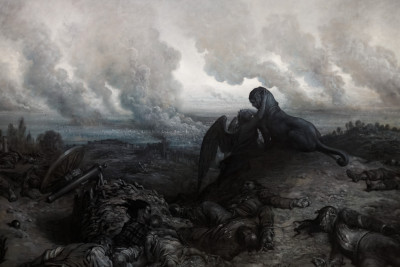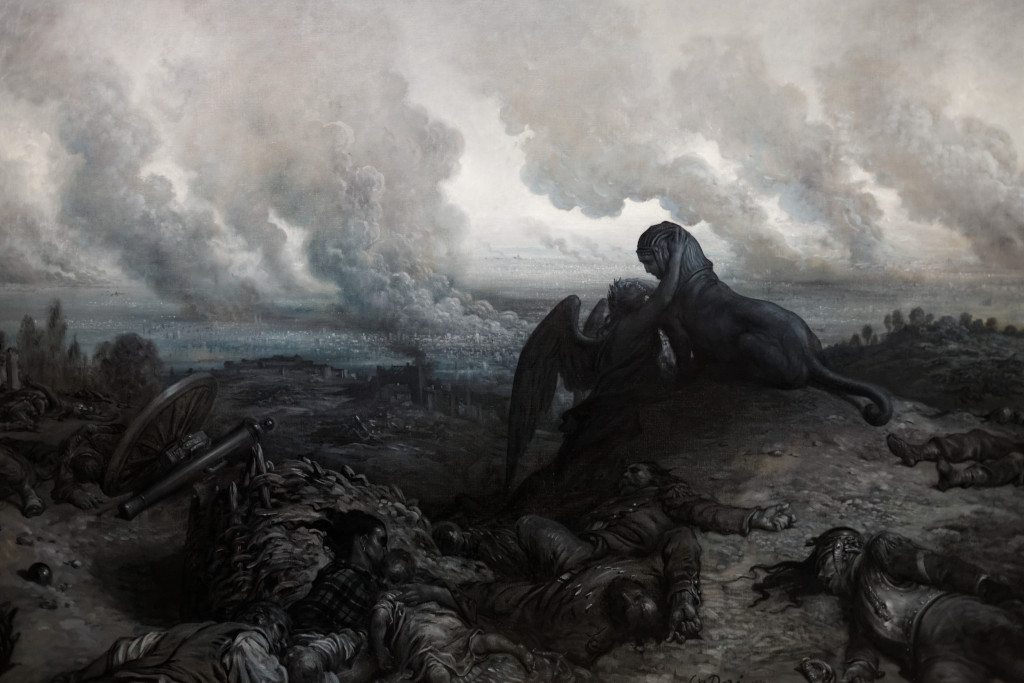The Enigma features a scene of carnage, as a city burns and bodies are strewn right across the composition. This was a painting by Gustave Doré that he completed in 1871.
Introduction
This artwork followed on soon after France's defeat to Prussia a year earlier. The painter was disturbed by these events and decided to include elements of the war within a number of new artworks. The Enigma is perhaps the most memorable of those, with the other titles being The Black Eagle of Prussia and The Defence of Paris. Although it was rare for the artist to focus on something so recent, he had covered the horrors of war many times already within his career and would do so again, later in the 1870s. Normally, these depictions would be illustrations, however, such as work for the History of the Crusades and also a number of scenes for a new publication of The Bible. In the case of The Engima, however, Gustave Doré chose to make use of his talents as a painter and this was an art form that he loved, but was unable to spare as much time in as he would have liked. His book illustrations provided a steady stream of income and so he had to work in that medium most of the time.
Despite working in oils for this piece, the artist chose not to bring a great variety of colour into the painting. Instead it is delivered in a reduced palette which helps to set the dark mood which is entirely appropriate for the content being covered. Dark shadows fall across most of the elements in the foreground, capturing the depressed mood which lingers after this latest bloody battle. The Engima is nearly two metres in width and the artist would experiment with large canvases on occasion, perhaps excited by the opportunity to work in a larger scale, when normally he would be constrained by his book illustrations. The larger canvas also enables considerable detail to be applied to the fallen soldiers in the foreground, though the darkened lighting makes it hard to make out some of these additional touches. Gustave Doré was not classically trained as a painter but worked hard to develop his technical skills within this medium, often asking his assistants to carry out tasks on his behalf to free up time for the great master.
Background behind the Prussian War
The Franco-Prussian War ran from 19 July 1870 to 28 January 1871 and was a highly significant conflict. The victory for Prussian forces would lead to the construction of what we now refer to as Germany, with many states running under the same leadership for the first time. Paris was surrounded for over four months before finally falling at the start of 1871, with the war over at that point. All that considered, these events would have been very fresh int the mind of the artist when he produced The Engima in that same year of 1871 and he was clearly distraught at the defeat handed out to France, as well as what the growing strength of the German Empire might mean for Europe as a whole. Many artists of that era would take elements of this conflict into their work, but few were most suited to the emotional nature of war whilst being technically gifted as was the case with Gustave Doré and so his decision to produce three paintings based on this event seemed entirely unsurprising.
Content
We find identify a number of bodies, soldiers, lying in the foreground. Elements of a battle field, such as the remains of a cannon, are strewn around the painting. Rolling hills place us at the top of a natural environment, looking down on a burning city below. Plumes of smoke rise into the air, with different fires running right across the horizontal of this painting. The sky itself is a single tone of grey, setting the mood and also reflecting the pollution left over by man after this bloody and brutal conflict. We then notice two figures in the foreground who potentially add some further meaning to this piece, namely a sphinx with it's head down, whilst a winged angel holds onto it in desparation. It is most likely that the angel is used to represent the nation of France, as it clings on for life with the angel holding to the sphinx. The latter can have many different meanings historically, but may represent compassion and fairness, which appears to have gone missing during this draining battle.
Location
The Engima can be found in the permanent collection of the Musée d'Orsay which is based in Paris, France. The museum has allowed this famous painting to be loaned out for a number of high profile exhibitions ever since around the 1980s, including to the likes of Strasbourg, Madrid and San Francisco. Doré remains a household name around whom exhibitions are common, but normally they would be aimed towards his illustrations. Curators will often want to vary their display, and so famous paintings such as The Enigma can help them to cover different interests within the same exhibition. The Musée d'Orsay itself is able to loan out items from its collection because of the incredibly rich and diverse selection that it possesses, which has been built and developed over many centuries.
Related Paintings
As mentioned elsewhere, The Enigma was a series of three paintings in which the artist commented on recent events within the Prussian War. With defeat for his native France, Gustave Doré's interpretation of events would always be delivered in a sombre, depressed mood. The other two artworks were The Black Eagle of Prussia and The Defence of Paris. Series of artworks were very common within his illustrations, often as commissioned groups of work which would be used to deliver new publications of classical literature but it was rarer for him to focus on several related themes in oils. Partly this was due to the low number of paintings that he actually worked on, as well as his desire to try out as many different genres as he could. Typically his paintings would be fitted in around his drawings, as the latter provided most of his income and also were the backbone behind his rising reputation across Western Europe.
Larger Image of The Enigma
See below for a larger image of the original painting, which might help you to see greater detail as added by Gustave Doré back in 1871. The artwork was 130cm in height, by 195.5cm in width. The artist often used large canvases in order to include as much detail as possible, particularly for his history or allegorical artworks. He was not much of a portrait painter, and concentrated on topics which were more appropriate to his status as a Romanticist painter. The same themes would continue into his illustrations and sculptures, with drama a key ingredient to his work, as well as strong emotions, such as sorrow and horror as found within The Enigma. As a particularly busy artist, he may also have been able to work on his paintings in phases, leaving intervals in which he could attend to his studio, before returning to each oil artwork.





